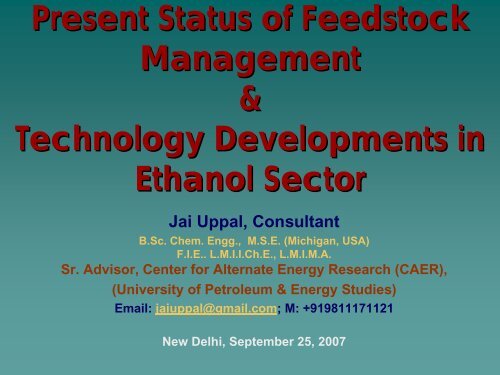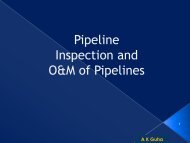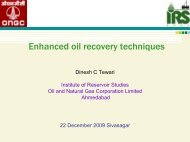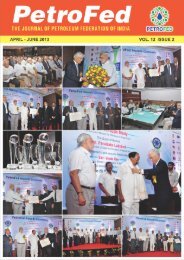Present Status of Feedstock Management & Technology ...
Present Status of Feedstock Management & Technology ...
Present Status of Feedstock Management & Technology ...
Create successful ePaper yourself
Turn your PDF publications into a flip-book with our unique Google optimized e-Paper software.
<strong>Present</strong> <strong>Status</strong> <strong>of</strong> <strong>Feedstock</strong><strong>Management</strong>&<strong>Technology</strong> Developments inEthanol SectorJai Uppal, ConsultantB.Sc. Chem. Engg., M.S.E. (Michigan, USA)F.I.E.. L.M.I.I.Ch.E., L.M.I.M.A.Sr. Advisor, Center for Alternate Energy Research (CAER),(University <strong>of</strong> Petroleum & Energy Studies)Email: jaiuppal@gmail.com; M: +919811171121New Delhi, September 25, 2007
<strong>Feedstock</strong>s For Ethanol Sugars: –Production– Sugarcane,– sweet sorghum,– sugar beet,– molasses (by-product <strong>of</strong> sugarproduction) - ‘A’, ‘B’ & ‘C’ heavy molasses– fruits etcStarches: –– Grains (Corn, wheat, rice, barley,sorghum) etc– Tubers (Cassava, potato etc) Cellulose – Grass, wood, MSW etc
Indian <strong>Feedstock</strong>s Molasses – main raw material + 90% <strong>of</strong>Ethanol/Alcohol Production Sugarcane – technology available andtested but cannot be used as sugarcaneprice very high – unviable for Ethanol Sweet Sorghum – high yielding varietybeing developed. Production technologybeing tested – one plant set up – This yearcommercial production. Tropical Sugar Beet – high yielding varietybeing tested – plant set up – trials taken -This year commercial production
Indian <strong>Feedstock</strong>s Fruits – only for wine Grains used for potable alcoholproduction as it is costly – rice,sorghum, barley, malt Damaged/unusable grain – sorghum Tubers – Cassava has been used insouth India for potable Alcohol Cellulose – <strong>Technology</strong> not yetdeveloped
Indian <strong>Feedstock</strong>s Molasses most economical feedstock Sugarcane most energy efficient crop- hard to beat. However, water intensive & one year crop. Negative impact in draughts and cost <strong>of</strong>production rises dramatically by up to30% but not as volatile as crude oil During drought, less water intensive cropsmay be economical– Sweet sorghum/tropical sugar beet – about4/6 months crop water intensity 1/3
Indian Ethanol Potential This year’s 12 mill T <strong>of</strong> Molassesavailability (for Ethanol). Canproduce 2.7 bill L <strong>of</strong> Ethanol Surplus Sugar produced this year 9mill Tonnes – no where to sell assurplus in the world – glut ! 5 mill tonne <strong>of</strong> sugar/ can beconverted to 2.8 bill L <strong>of</strong> Ethanol E10 Blending Program requires 1.2bill L <strong>of</strong> Ethanol
Indian Ethanol Potential 1 mill ha (<strong>of</strong> 60 mill ha) <strong>of</strong> irrigatedland can produce 5 bill L <strong>of</strong> Ethanol 5% damaged grain – 11 mill T canproduce – 4 bill L <strong>of</strong> Ethanol Surplus Biomass <strong>of</strong> 500 mill T canproduce 100 bill L per year Or 50% <strong>of</strong> 120 mill T <strong>of</strong> Bagassefrom sugar mills can produce 12 billL <strong>of</strong> Ethanol
Indian Ethanol Blending Program(EBP) Ethanol Used in WW II – ‘PowerAlcohol’ in UP <strong>Technology</strong> Azeotropic distillationusing benzene Stopped after the War R&D & Trials in 1979-80, 91-92,92, Pilot projects in 2002 – 3 locations,300 dispensing stations
Indian EBP E5 blending made mandatory in 9 states& 4 UTs from Jan 1, 2003 Made conditional from Oct 2004 Resumed in 2006 & picks up momentum in2007 – E5 introduced in Delhi 1 st time ! Announcement to introduce E5 in all Indiaexcept J&K, NE and Islands Intention to introduce E10 by Nov 2008 Alcohol capacity <strong>of</strong> +3.5 bill L Installed Ethanol capacity <strong>of</strong> about 1.5 bill L
Ethanol Requirement for EBPYear %BlendEthanolRequirement(MMT)GasolineDemand(MMT)2006/07 5 0.5 10.072011/12 10 1.29 12.852011/12 25 3.21 12.85
<strong>Feedstock</strong>s for Ethanol ProductionCANEMOLASSESCANE JUICEGRAINGRAINBEETDRY MILLINGWET MILLINGGLUTENDILUTIONPRE -CLARIFICATIONSLURRYPREPARATIONLIQUIFACTIONSLURRYPREPARATIONLIQUIFACTIONFIBRESJUICEEXTRACTIONCONCENTRA-TIONSACCHARIFICATIONSACCHARIFICATIONFERMENTATIONFERMENTATIONFERMENTATIONFERMENTATIONFERMENTATIONDistillationHIGH QUALITY- ENADEACTIVATED SPIRITAZEOTROPICDISTILLATION(HEXANE)ANHYDROUSALCOHOL/ETHANOLMOLECULAR SIEVEANHYDROUSALCOHOL/ETHANOL
<strong>Status</strong> <strong>of</strong> Indian Ethanol<strong>Technology</strong> Average capacity <strong>of</strong> plant 40 KLPD asagainst 300 to 1000 KLPD in USA/Brazil Level <strong>of</strong> average technology improving Cost <strong>of</strong> production – economies <strong>of</strong> scalewill be achieved as EBP progresses Some Plants converting to multi feedstockplants Price around Rs 21.50 per L can bebrought down if blending program isexpanded Small inefficient plants will die !
Ethanol Process <strong>Technology</strong>Process steps in Ethanol Production<strong>Technology</strong>:1. Convert starch to sugar2. Ferment Sugar using yeast to produce weaksolution <strong>of</strong> Alcohol (7% to 9%)3. Distill alcohol to around 95% V/V4. Dehydrate Alcohol using Mol. Sieve to +99.7%For Molasses step 1 is avoided – <strong>Technology</strong>using Molasses and some grains is wellestablishedHowever technology being commercializedto handle sugar beet and sweet sorghumContinuous fermentation technologybecoming popular especially larger Plants
Simplified Ethanol ProcessFlowsheetAlcohol ProductionSimultaneousGrain crushing Mashing Sacchrification Fermentation DistillationMolassesCane juice
Fermentation <strong>Technology</strong> Batch Fermentation – being phased out Continuous Fermentation:-– without yeast recycle– or with yeast recycle Theoretically yield (fermentation efficiencyin ascending order but in actual practicemay not be so) Effect <strong>of</strong> quality <strong>of</strong> molasses & control <strong>of</strong>operation
Fermentation <strong>Technology</strong> Higher efficiencies being attaineddespite the molasses qualitydeteriorating Ethanol from ‘A’ heavy molasses and‘B’ heavy molasses no problem Ethanol from Sugarcane juice not inuse but feasible by adding clarifyingand evaporation equipment
Distillation <strong>Technology</strong> Atmospheric Distillation being phased out Multi pressure (pressure-Vacuum)technology becoming popular lower steam consumption & downtime Introduced much earlier in India – ahead<strong>of</strong> Brazil in energy efficiency Reboilers instead <strong>of</strong> direct sparging <strong>of</strong>steam Lower water consumption
Dehydration <strong>Technology</strong> Ethanol Production– Technologies Molecular Sieve (MS) - <strong>Technology</strong> <strong>of</strong> 90s Azeotropic Distillation(AD) - Old Polluting <strong>Technology</strong> Membrane - Yet to be stabilized - Membrane life Molecular Sieve technology under licensefrom US firms – Pressure SwingAdsorption (PSA) process Low steam consumption <strong>of</strong> 0.6 kg per L <strong>of</strong>Ethanol & long life <strong>of</strong> Mol sieve established– ahead <strong>of</strong> Brazil Higher level <strong>of</strong> Instrumentation andDCS/PLC systems being introduced inalmost all in new plants
Effluent Treatment & Utilities Distillery Effluent very rich in organic matter– very high BOD and COD Major Issue & also an opportunity to use richhumus and nutrients in effluent Zero effluent discharge Primary Effluent Treatment Bio-methanation Bio-composting using press mud from sugarmills and distillery effluent Reverse osmosis/Evaporation being used toreduce quantity <strong>of</strong> effluent, increase DS andreduce water consumption by recycling Incineration in Boilers or spray drying High Water use issues –being being addressed
Effluent Treatment & Utilities Efficient Bio-methanation provides up to90 to 100% <strong>of</strong> Fuel for steam fordistillation and dehydration Increasingly Ethanol plants are integratedwith sugar mills and have their own highpressure boilers and turbines withalternators to generate power not only forthe Distillery / Ethanol plant but also forthe <strong>of</strong>fices and residences or otherindustrial uses such as Alcohol basedchemicals etc.
<strong>Technology</strong> & Plant Sourcing All Alcohol/Ethanol Plants made inIndia Indian Alcohol/Ethanol technologyand plant suppliers have arrived onthe world stage ! Plants being sold in all most allcontinents Indian Alcohol technology and plantsbeing sold all over the world becauseit is efficient and with lower capitalcosts
Thank You !
















